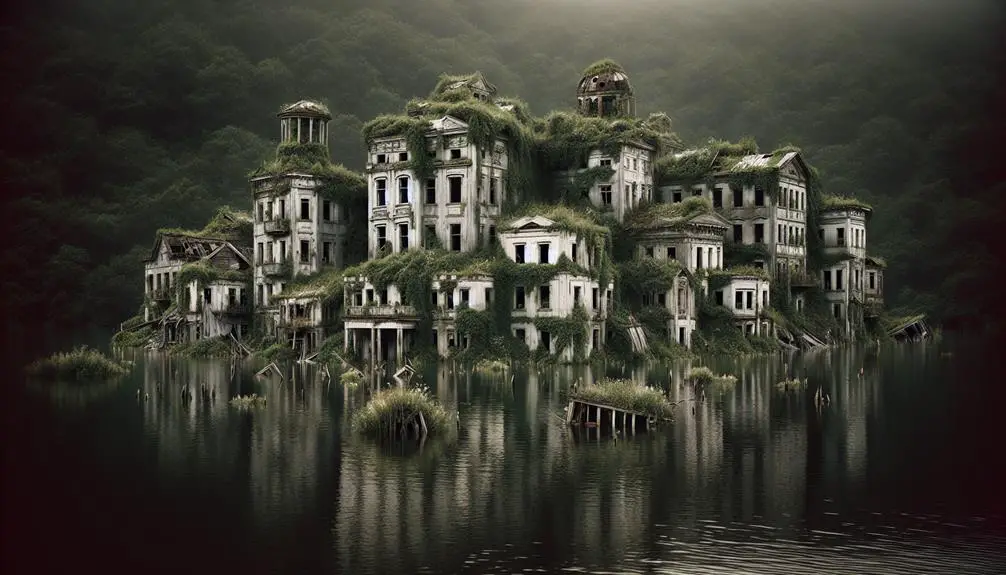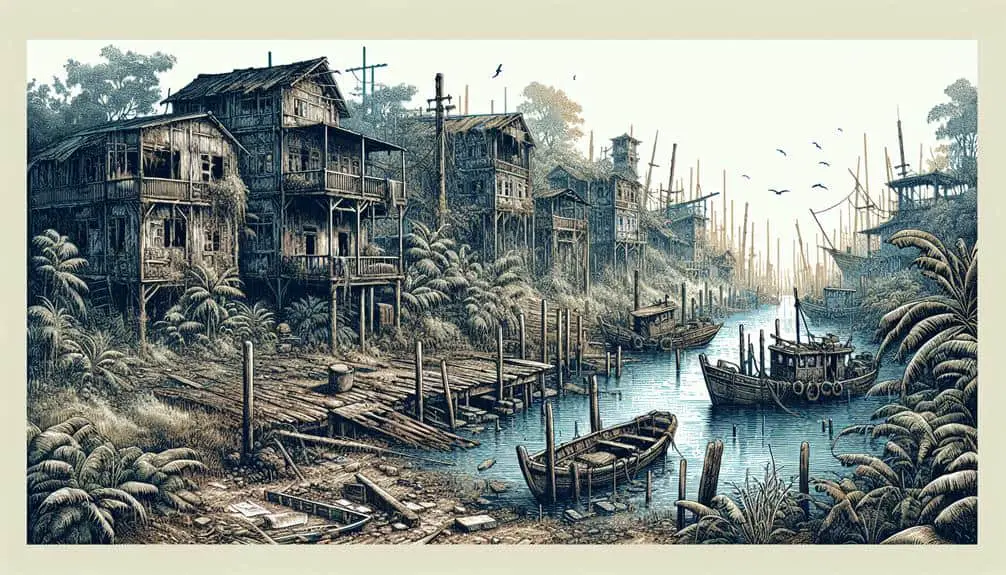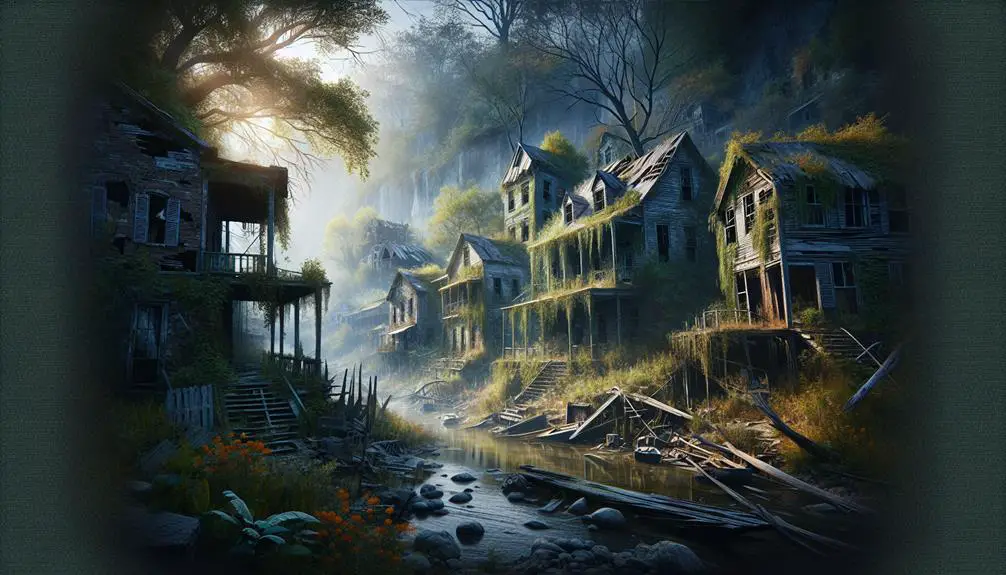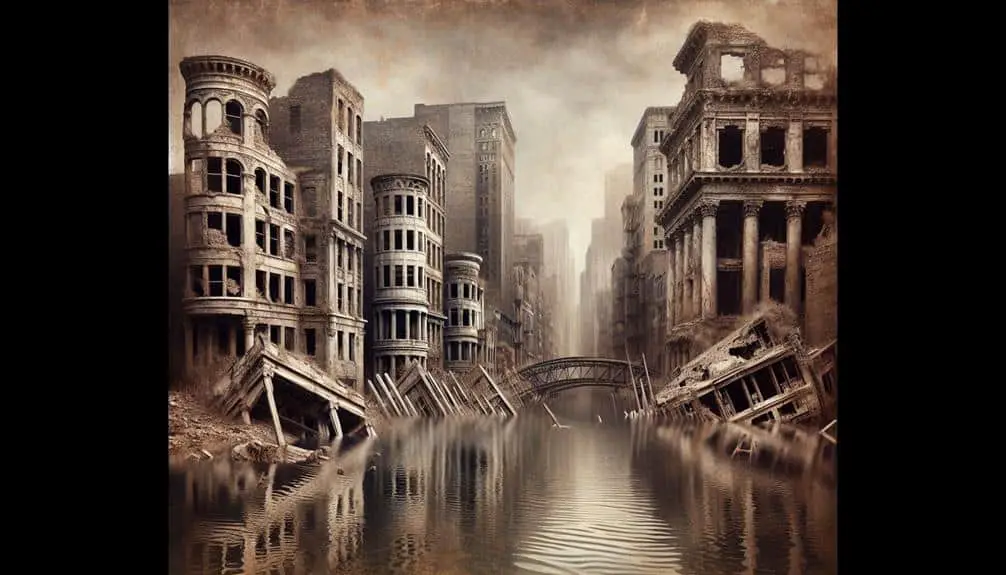Explore flooded ghost towns along American waterways to uncover submerged relics of the past. Discover hidden structures and artifacts offering insights into bygone eras. Utilize caution and specialized equipment for safe navigation. Preservation efforts balance exploration and conservation, aided by technological advancements. Challenges like funding and environmental impact require strategic solutions. Uncover the thrill of unraveling history beneath the waters.
Key Points
- Understand potential dangers in submerged areas for safe navigation.
- Use detailed maps and sonar technology for guidance in flooded ghost towns.
- Exercise caution to prevent accidents and preserve historical artifacts.
- Utilize specialized equipment for safe exploration in sunken settlements.
- Prioritize safety precautions while exploring submerged structures.
History of Flooded Ghost Towns
When examining the history of flooded ghost towns, it's important to analyze the causes of their submersion and the societal impacts that ensued. These lost communities, now submerged beneath waterways, hold a wealth of historical significance. The submersion of these towns often stems from the construction of dams for hydroelectric power generation or flood control measures. As a result, once-thriving settlements met a watery fate.
The remnants of these ghost towns lie beneath the surface, preserving a snapshot of a bygone era. Underwater artifacts such as old buildings, streets, and even personal belongings offer a unique glimpse into the past. Studying these submerged relics provides valuable insights into the daily lives of those who once called these towns home.
The disappearance of these communities not only erased physical landmarks but also had lasting societal impacts. The relocation of residents, the loss of economic hubs, and the disruption of local cultures all contribute to the intricate narrative of flooded ghost towns. Understanding the history of these submerged settlements is important in unraveling the complexities of our past.
Exploring Submerged Structures
Dive deep into the submerged world of flooded ghost towns to uncover the hidden structures that offer insights into their past inhabitants and way of life. Exploring these sunken remnants provides a fascinating glimpse into history through underwater artifacts and hidden treasures.
Underwater artifacts, such as abandoned buildings, bridges, and even vehicles, serve as pivotal time capsules waiting to be discovered. By studying these submerged structures, archaeologists and historians can piece together the daily lives of those who once inhabited these now-flooded areas. The preservation of these hidden treasures is essential to understanding the cultural heritage of these ghost towns.
Excavating and documenting these submerged structures require specialized equipment and skills. Surveying the underwater landscape meticulously is vital to unearth artifacts without causing damage. By carefully cataloging and analyzing these finds, researchers can reconstruct the past with accuracy and detail.
The allure of exploring submerged structures lies in the thrill of uncovering forgotten remnants of the past. These hidden treasures beneath the water's surface offer a unique perspective on the lives of those who came before us.
Challenges of Preservation Efforts
Preservation efforts for submerged structures in flooded ghost towns present significant challenges requiring specialized expertise and meticulous attention to detail. When addressing the funding obstacles, it becomes essential to secure financial resources for underwater archaeology, structural stabilization, and long-term conservation plans. Community involvement plays an important role in raising awareness, garnering support, and ensuring sustainable preservation strategies.
The environmental impact on submerged structures is an important consideration. Factors like water quality, sediment accumulation, and aquatic life interactions can affect the integrity of these historical sites. Balancing conservation efforts with environmental preservation is key to maintaining the delicate ecosystem while safeguarding the submerged heritage.
Moreover, archaeological discoveries in flooded ghost towns provide valuable insights into the past. Careful excavation, documentation, and analysis of artifacts are crucial for understanding the cultural significance of these underwater sites. Collaborating with experts in underwater archaeology enhances the accuracy and breadth of historical knowledge gleaned from these submerged structures. By overcoming funding obstacles, engaging the community, mitigating environmental impact, and prioritizing archaeological discoveries, preservation efforts can successfully navigate the challenges posed by submerged ghost towns.
Effective navigation in flooded ghost towns requires understanding the layout of submerged structures and utilizing specialized equipment for safe exploration. When setting out on your journey to these submerged settlements, safety precautions should be your top priority. Always make certain you have proper safety gear such as waterproof flashlights, helmets, and sturdy footwear.
Familiarize yourself with the area's potential hidden dangers, including unstable debris, sharp objects, and unpredictable currents.
Before diving into the depths of these ghostly waters, make sure to have a detailed map of the sunken town to guide your exploration. Utilize sonar technology to map out submerged structures and identify potential hazards beneath the surface. When moving through the flooded streets and buildings, proceed with caution and avoid disturbing the underwater environment to prevent accidents and preserve historical artifacts.
Future of Sunken Settlements
When contemplating the future of sunken settlements, understanding the environmental impact and potential for preservation is essential for sustainable exploration and conservation efforts. Advancements in underwater archaeology and urban exploration have shed light on the significance of these submerged sites. Here are five key points to ponder:
- Preservation Challenges: The delicate balance between exploring sunken settlements and preserving them for future generations.
- Technological Innovations: How cutting-edge technology aids in mapping and documenting sunken structures with precision.
- Environmental Sustainability: Strategies to minimize the ecological impact of underwater expeditions in flooded ghost towns.
- Cultural Heritage: The importance of protecting the historical and cultural value of sunken settlements.
- Public Engagement: Involving the community in the exploration and preservation of these submerged sites to foster awareness and appreciation.
Frequently Asked Questions
Can Visitors Scuba Dive or Snorkel in the Flooded Ghost Towns Along American Waterways?
You can't scuba dive or snorkel in the flooded ghost towns along American waterways. It's a forbidden thrill, a tantalizing secret waiting to be unearthed. But beware, hidden dangers lurk beneath those murky depths.
Are There Any Regulations or Restrictions in Place for Exploring Submerged Structures in These Sunken Settlements?
When exploring submerged structures in sunken settlements, be mindful of regulations and restrictions in place for safety, preservation, and research. These rules guarantee the exploration is conducted responsibly, respecting historical sites and promoting a secure environment for all.
How Do Natural Disasters Such as Hurricanes and Flash Floods Impact the Preservation Efforts of Flooded Ghost Towns?
When natural disasters strike, the intricate balance of preservation in flooded ghost towns faces a tumultuous challenge. The impact of climate events like hurricanes and flash floods can both erase and reveal archaeological discoveries, reshaping historical narratives.
Looking to explore historical ruins in flooded ghost towns? Boat tours offer guided excursions through submerged streets and buildings, providing a unique perspective on the impact of natural disasters. Experience the eerie beauty of these submerged relics firsthand.
What Technologies or Techniques Are Being Used to Document and Study the Sunken Settlements for Future Research and Preservation Efforts?
To explore sunken settlements, advanced underwater archaeology combines with cutting-edge 3D mapping. This innovative approach not only documents but also conserves these submerged historical sites, revealing mysteries of the past for future generations to discover.



